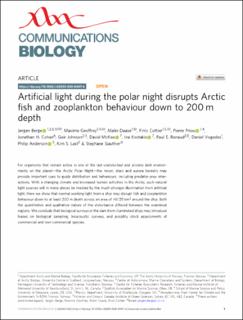| dc.contributor.author | Berge, Jørgen | |
| dc.contributor.author | Geoffroy, Maxime | |
| dc.contributor.author | Daase, Malin | |
| dc.contributor.author | Cottier, Finlo Robert | |
| dc.contributor.author | Priou, Pierre | |
| dc.contributor.author | Cohen, Jonathan H. | |
| dc.contributor.author | Johnsen, Geir | |
| dc.contributor.author | McKee, David | |
| dc.contributor.author | Kostakis, I | |
| dc.contributor.author | Renaud, Paul E. | |
| dc.contributor.author | Vogedes, Daniel Ludwig | |
| dc.contributor.author | Anderson, Philip J. | |
| dc.contributor.author | Last, Kim | |
| dc.contributor.author | Gauthier, Stephane | |
| dc.date.accessioned | 2020-06-10T07:40:45Z | |
| dc.date.available | 2020-06-10T07:40:45Z | |
| dc.date.created | 2020-03-23T15:58:45Z | |
| dc.date.issued | 2020 | |
| dc.identifier.citation | Communications Biology. 2020, 3 (102), | en_US |
| dc.identifier.issn | 2399-3642 | |
| dc.identifier.uri | https://hdl.handle.net/11250/2657439 | |
| dc.description.abstract | For organisms that remain active in one of the last undisturbed and pristine dark environments on the planet—the Arctic Polar Night—the moon, stars and aurora borealis may provide important cues to guide distribution and behaviours, including predator-prey interactions. With a changing climate and increased human activities in the Arctic, such natural light sources will in many places be masked by the much stronger illumination from artificial light. Here we show that normal working-light from a ship may disrupt fish and zooplankton behaviour down to at least 200 m depth across an area of >0.125 km2 around the ship. Both the quantitative and qualitative nature of the disturbance differed between the examined regions. We conclude that biological surveys in the dark from illuminated ships may introduce biases on biological sampling, bioacoustic surveys, and possibly stock assessments of commercial and non-commercial species. | en_US |
| dc.language.iso | eng | en_US |
| dc.publisher | Nature Research | en_US |
| dc.rights | Navngivelse 4.0 Internasjonal | * |
| dc.rights.uri | http://creativecommons.org/licenses/by/4.0/deed.no | * |
| dc.title | Artificial light during the polar night disrupts Arctic fish and zooplankton behavior down to 200 m depth | en_US |
| dc.type | Peer reviewed | en_US |
| dc.type | Journal article | en_US |
| dc.description.version | publishedVersion | en_US |
| dc.source.volume | 3 | en_US |
| dc.source.journal | Communications Biology | en_US |
| dc.identifier.doi | 10.1038/s42003-020-0807-6 | |
| dc.identifier.cristin | 1803052 | |
| dc.relation.project | Norges forskningsråd: 244319, 245923, 300333,223254 | en_US |
| dc.description.localcode | Open Access This article is licensed under a Creative Commons Attribution 4.0 International License, which permits use, sharing, adaptation, distribution and reproduction in any medium or format, as long as you give appropriate credit to the original author(s) and the source, provide a link to the Creative Commons license, and indicate if changes were made. The images or other third party material in this article are included in the article’s Creative Commons license, unless indicated otherwise in a credit line to the material. | en_US |
| cristin.ispublished | true | |
| cristin.fulltext | original | |
| cristin.qualitycode | 1 | |

